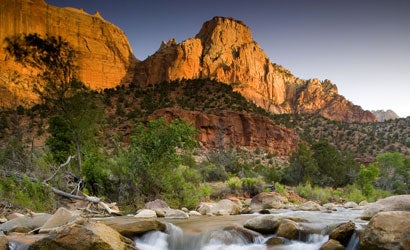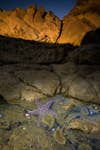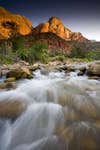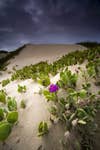Flash Where You Least Expect It
Use flash outdoors for effects that keep the spotlight on the natural world.

Taking the perfect photograph is like creating the perfect pastrami sandwich: You pile on the pastrami higher and higher, and just when you think it’s enough — you add one more slice. In nature photography, your flash can be that extra slice.
It isn’t surprising that outdoor shooters often overlook the humble flash. Perhaps it’s the abundance of natural sunlight, or fear of the overly artificial look.
It wasn’t so long ago that I had the same flash aversion, until a little boredom (the true mother of discovery) led me to some experimentation. Before I knew it, foregrounds were popping, shadows became tools for adding depth, and a new style began to emerge in my images. Finally, I had enough slices stacked up for that perfect pastrami sandwich.
To get the job done, you need at least one accessory strobe. I use the Canon 580EX Speedlite, which is powerful enough to mimic studio-quality lighting and more than enough to get the job done outdoors, at a reasonable weight of about 13 ounces. (Size and weight are definitely a consideration for nature shooting, which almost always involves some hiking.)
Most DSLR manufacturers and a number of independents make comparable dedicated accessory strobes; go to page 2 for a sidebar on appropriate units.
Two strobes (with fresh batteries!) are ideal, especially for more creative lighting. These dedicated flashes are TTL (through the lens) auto, meaning that they measure the flash illumination at the moment of exposure to balance the flash output with your camera’s exposure readings. It’s also very important to have a flash that has some other advanced options, particularly the ability to dial in the power of your strobe in EV increments, similar to f-stops. For example, a +1/3 EV or +0.3 EV is a small boost of fill light about equal to 1/3 stop; a +3.0 EV setting is a big 3-stop boost in light. Another worthwhile feature is variable manual output, which lets you set your flash to full power, 1/2-power, 1/4-power, down to a tiny spit of light.
Now it’s time to accessorize. You will need an off-camera shoe cord. I’ve never taken a landscape photo with my flash mounted to the top of my camera — it’s always off to one side or the other. The manufacturer’s dedicated off-shoe cord retains full TTL automation, allowing you to aim it in any direction.
If you want to go wireless, which gives you ultimate control, you can opt for a shoe-mounted infrared transmitter (Canon, Nikon), use the camera’s built-in flash as a remote controller (Nikon, Pentax, Sony, and the new Olympus E-3), or use a second accessory flash in the hot shoe as a remote controller for other flashes (Canon, Nikon, Pentax, Samsung, Sigma, Sony).
| © Ian Shive / Aurora Photos |
| Rescue Hidden Detail, Malibu Beach, CA: Tripod-mounted Canon EOS 5D with 16-35mm f/2.8L Canon EF lens. Exposure, 1/2 sec at f/22, (-1.5 EV from the meter reading to maintain deep shadows). Canon 580EX Speedlite fired using off-camera TTL cord. |
These systems have limited ranges, and the flash units must be within the sightline of the transmitter. Longer distances and tricky configurations require a radio transmitter such as the PocketWizard Plus II Transceiver ($190, street), although you’ll lose TTL automation.
I also recommend a pocket diffuser, such as those made by LumiQuest, to provide more even and natural-looking flash.
Here are some of the many ways to use flash to enhance nature shots.
Rescue Hidden Detail
The sun was only minutes from setting on Malibu Beach when I happened upon this tide pool with a perfectly positioned starfish (photo at right). But in deep shade, with only a sliver of warm light hitting the rocks just above it.
I decided to use a spotlight effect on the tide pool, knowing that a broader fill flash would look artificial and not draw the eye to the starfish. I used two graduated ND filters (0.6 and 0.9, for a total of 5 stops) to balance the bright sunlight at the top. Using an off-camera sync cord, I handheld the flash as close to the left of the tide pool as possible without my hand or flash in the frame.
While still clearly artificial, the spotlight draws your eye immediately to the focal point, and creates three distinct layers — the tide pool, the shadowed rocks, and the warmly lit rocks above — which add depth.
Dynamic Range Boost
A fill flash can be crucial when photographing in high-contrast situations such as the lefthand photo on the opening spread. As the rising sun hit the face of Sentinel Peak in Utah’s Zion National Park, I was faced with the challenge of balancing the bright background with the deep shadows of the foreground. I used a Lee 3-stop graduated neutral-density filter (0.9) to help balance the sky to the rest of the shadows.
But because I was in the shade, the water remained lackluster. To brighten the white foam of the river, I held the Speedlite at a distance from the water with my arm extended out, using a PocketWizard to trigger it at 1/32 power. (If you fire a flash too close to moving water, you get tiny white spots all over.) With the slow shutter speed, the flash also freezes the rushing water for a ghostly blurring effect.
Spotlight Detail
For landscape photographers, mid-afternoon is for lunch and napping, right? Not always true.
While hiking the dunes in Pismo Beach, CA, I came across great wildflowers (righthand photo on opening spread). Overhead sun and mixed clouds made the light dull. So for more drama, I moved extremely close with my zoom at 16mm fitted with a Lee 2-stop graduated ND filter to help make the sky look more ominous. Using an off-camera sync cord, I handheld my Speedlite just out of frame, as close to the dune as possible, for a spotlit effect.
While the light is obviously artificial, it works by giving a new perspective to a relatively plain scene.
| The Flash to Have****Dedicated Units These camera makers’ full-featured accessory flash units offer variable flash output (flash exposure compensation) on TTL auto, as well as manual flash with adjustable levels. They are compatible with current digital and film SLRs from the respective manufacturers. But they are not necessarily backward-compatible with older SLRs, nor will older flash units necessarily work with current cameras. Check the manufacturer’s specs carefully before you buy. Canon Speedlite 580EX II ($405, street) Nikon Speedlight SB-800 AF ($315 street) Olympus FL-50 ($365, street) Pentax AF540FGZ ($335, street) Samsung SEF-54PZF (discontinued, available at some retailers for about $275, street) Sigma EF-530 DG Super ($260, street); EF-530 DG ST ($190, street) is identical but lacks wireless TTL operation. Third-party Units These accessory TTL flashes that can be used with other manufacturers’ cameras. As above, do not assume compatibility; check to make sure a flash works with your specific make and model camera. Metz 58 AF-1 for Canon ($375, street) and Nikon ($350, street). Nissin Di622 ($170, street): models for Canon and Nikon. Sigma EF-530 DG Super ($260, street) and EF-530 DG ST ($190, street) for Canon, Nikon, Pentax, Samsung, and Sony. Sunpak PZ 5000 AF ($150, street): models for Canon, Nikon, Pentax, Samsung, Sony. |
Add Contrast
Working in the shadow of El Capitan in California’s Yosemite National Park, the morning sun had yet to hit the valley floor where I was rummaging through leaves thick with morning frost. With my tripod legs out as far as they could go, I got within inches of this textured aspen leaf (above) for a 1:2 ratio with my 50mm macro lens. But the light was too diffuse, preventing me from dramatically capturing the edges of the veins and frost on the leaf — I needed subtle directional light.
So I placed my Speedlite (attached by a cord) flat on the ground along one side about a foot away from the leaf, firing it on TTL set to -2.3 EV to keep from overpowering the subject. I also set the camera exposure to -0.7 EV to compensate for the extra light and to strengthen the blacks of the shadows.
Compensate For Backlight
Photographing people outdoors gives a great sense of perspective. The challenge in capturing a backlit woman hiking through wildflowers (page 28) was to balance the direct sunlight just behind the hiker while keeping the scene looking natural.
I handheld my Speedlite off-camera while moving at an equal pace with the hiker. I metered for the wildflowers, then opened up the lens by 1.5 stops to counteract the direct sun’s influence on the camera’s autoexposure. The flash output was low enough to avoid overcompensating for the backlight and add just enough fill so that the hiker isn’t a silhouette.
Shadow Fill
This is one of the most basic and practical setups for outdoor flash. My composition above put the sunset at Malibu, CA, directly in front of me, throwing shadows on the foreground rocks. I filled the shadows with just enough flash to bring out the detail without sacrificing the natural feel.
The tricky part was having to work quickly — every time a wave came up, the tripod would sink in the sand and throw off my horizon line. So I set my Speedlite (with LumiQuest diffuser) to manual at 1/32 power, handheld it pointing directly into the shadowy area of the rock, and triggered it wirelessly with a PocketWizard.
Los Angeles-based Ian Shive, an Aurora Photos photographer, specializes in outdoor lifestyle and nature. Visit www.waterandsky.com.

Rescue-Hidden-Detail-Malibu-Beach-CA-Tripod-mou

Dynamic-Range-Boost-Zion-National-Park-UT-Tripo

Spotlight-Detail-Pismo-Beach-CA-Tripod-mounted

Shadow-Fill-Malibu-CA-Tripod-mounted-Canon-EOS

Compensate-for-Backlight-Santa-Cruz-Island-CA-H

Add-Contrast-Yosemite-National-Park-CA-Tripod-m